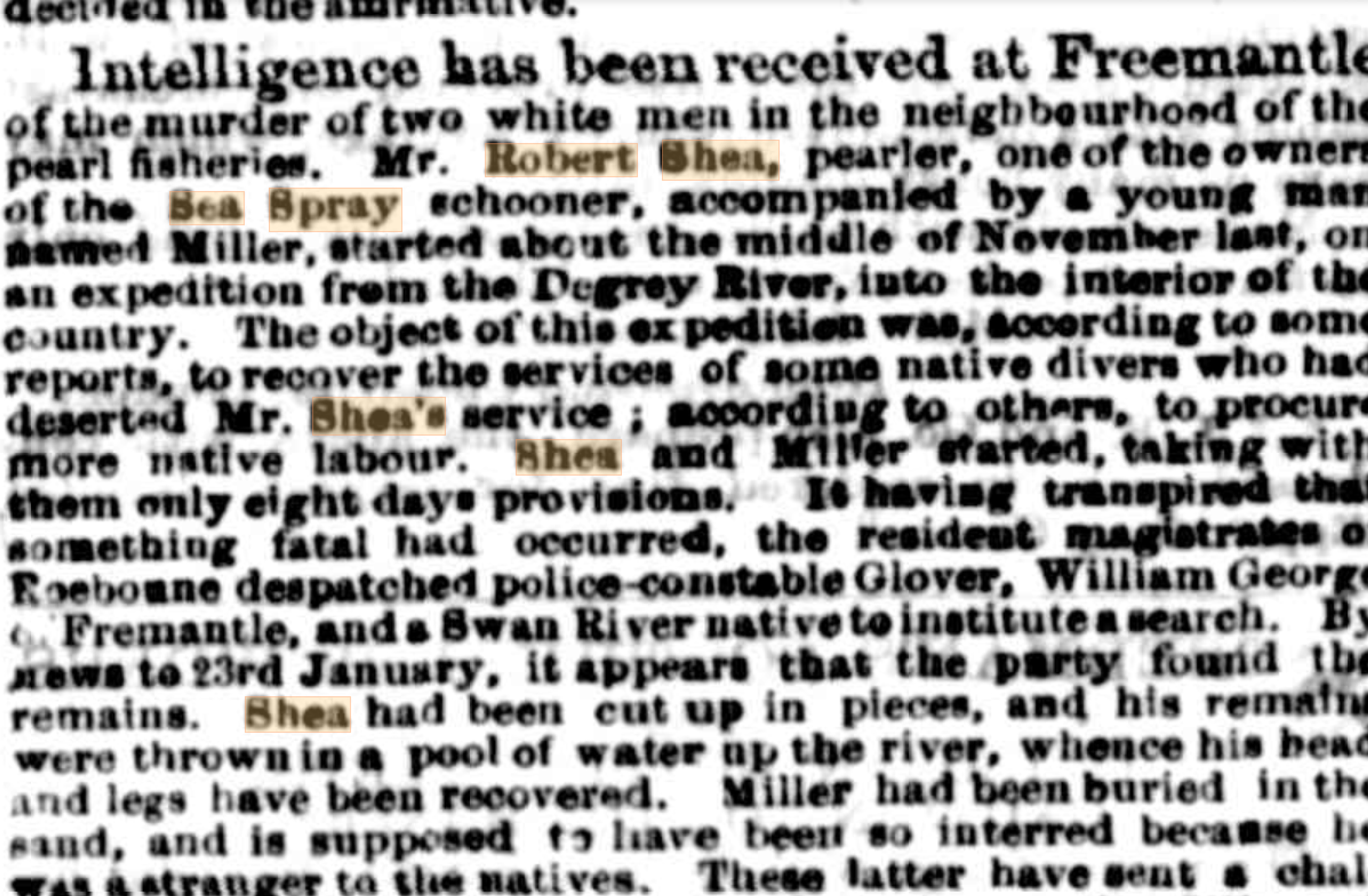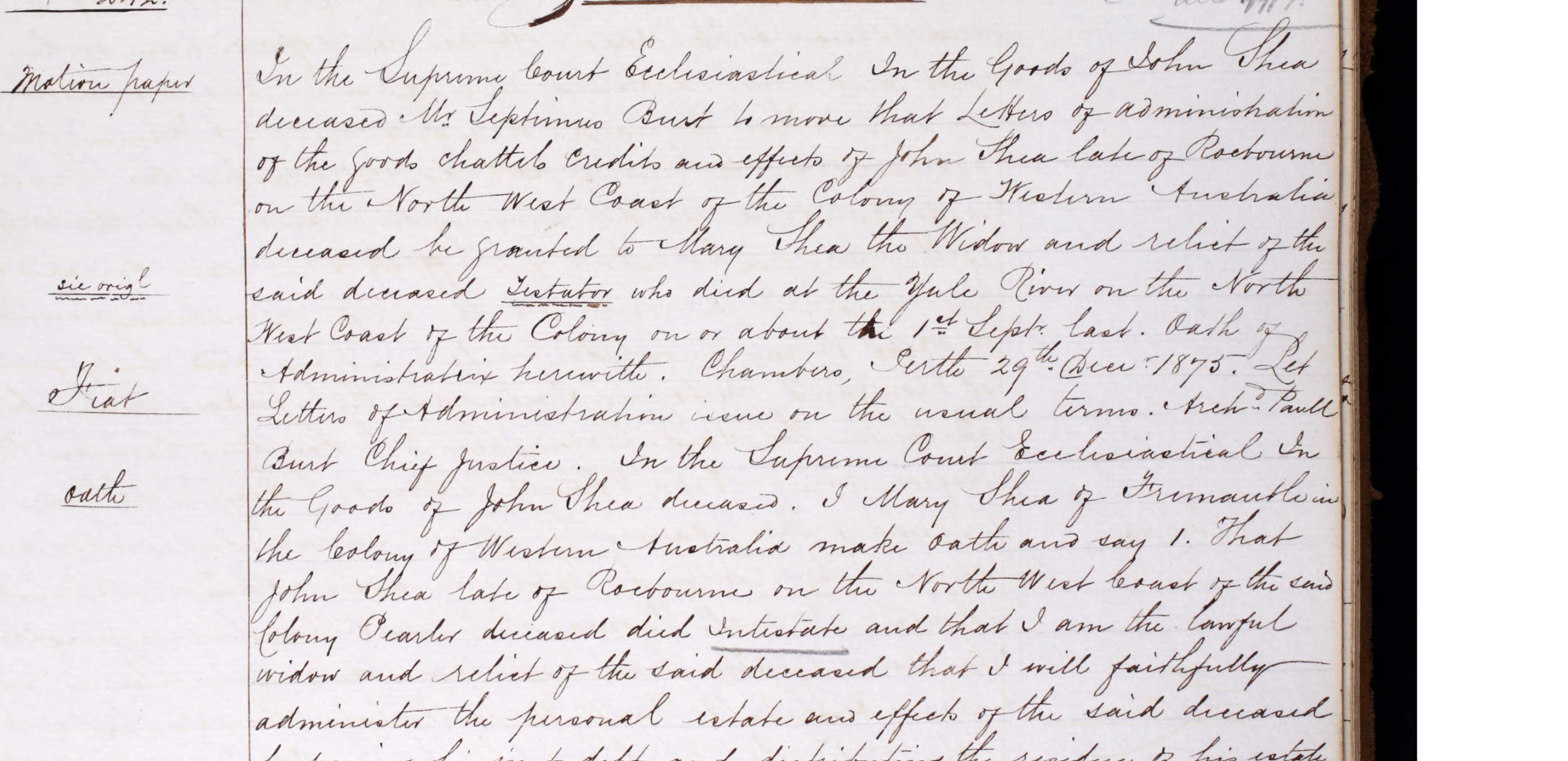Robert Shea and Samuel Miller
Vessel Name: Sea Spray
Robert Shea and Samuel Miller
Murdered at Muccan Station; body recovered
5 September 1872
Cultural content warning - this story contains content about blackbirding and historical racism. FLatSea attempts to present history as it happened, and we acknowledge some of our history is culturally disturbing to some readers.
Our memorial trail exists to honour our lost fishers and their contribution to our life in Western Australia today. Out of respect for the First Nations People affected by blackbirding, it is our decision to omit the characters in this story from the memorial trail.

Newspaper details

Intestate details
Sea Spray was one of the fastest two-masted schooners on the Western Australian. She was built by William Jackson in his Fremantle boat yard for John and Walter Bateman, ship owners and merchants based in Fremantle. Sea Spray was numbered 1 of 1862, and her official number was 36546. She was 50.7 feet long [15.45 metres], 15.1 ft [4.6 m] across her beam and had a draft of 7.1 ft [2.16 m]. Sea Spray was a pearling vessel. She also carried valuable pearls and shell south for sale and brought all manner of cargo and passengers to the busy pearling and pastoral settlements along the coast.
Her sale/lease to Robert Shea brought her to an unsavory career. She became a blackbird boat, taking abducted Aboriginal divers to the northwest to dive for pearl shell.
Robert Shea was born in Ireland in 1833. Robert came to Western Australia aboard the Burlington in 1863, via a nomination by his brother-in-law William Connell. In 1865 he married Mary Meehan who was also Irish.
By the rules of the indenture contracts, Shea was meant to return crew members back to country at the end of their contracted period but that was not one of his priorities. Despite new laws banning neck chains, Shea continued to use them to march Aboriginal people to the Sea Spray. He ignored the laws banning the use of women and children on pearl boats, and he became a notorious kidnapper, detaining people in barracoons on small islands off the northwest coast [such as Barrow Island] so they couldn’t escape
Newspapers advertised prices for vessels with/without a crew. The Herald newspaper in 1873 advertised the Dolphin for sale at £440 for the boat, or £1300 for the boat with divers. Shea took Aboriginal people to be sold along with pearling vessels, in league with a boat seller called Police Constable Albert Francisco. Ironically, the cutter Cygnet owned by the Francisco brothers had been chartered by the government to inspect pearl boats and ensure divers and pump hands were being treated humanely.
Shea and police constable Francisco were involved in the shooting of Toonawarra, an Aboriginal of Cooyapooya Station. The Aboriginal community were disturbed when there were no repercussions for the shooting.
Shea became one of the most notorious blackbirders on the WA coast, working between the DeGrey and Ashburton Rivers, into the Kimberley, and as far south as Shark Bay and the Gascoyne region. He took people from inland regions who were not from saltwater tribes and could not swim. They drowned or were simply thrown overboard at sea.
Divers could be branded with their owners’ symbol in the event they attempted to leave the employ of a boat or a master. The law stated at that time that an indentured worker could be found and returned to the master holding the indenture. Police could detain absconders in the lock-up and the Court could fine them and send them back to the pearling vessel they came from.
Robert Shea had multiple business partners. They included blackbirders Thomas Mountain, John Hickey, and Julius Brockman. Shea’s closest ally was Samuel Miller, the mate aboard Sea Spray. He was popular with the Aboriginal people he dealt with because he did not use violence against them. Shea’s younger brother John and Millers younger brother were aboard Sea Spray. It is unclear when Shea and Miller met, or how old Miller was.
Since his appointment in 1860 Resident Magistrate Robert John Sholl at Roebourne had invested in pearl boats that used indentured workers. He overlooked Shea’s illegal dealings and declined to prosecute even when there were deaths from mistreatment. Magistrate Sholl had invested in pearl boats, and his sons were pearlers using cheap indentured labour provided by Shea and other blackbirders. Sholl remained in his position for 15 years, supporting blackbirding and mistreatment of labour. He was eventually forced to resign in 1881. Governor Weld described Sholl as a “disgrace to the British name”.
At the end of August 1872 Shea moored the Sea Spray in Roebourne. He had experienced three profitable pearling seasons, as well as the extra money made from blackbirding. He delivered some of his crew to one of his barracoons, moored his boat and allowed shore-leave for remaining crew.
Four of the crew with shore-leave absconded. That was unexpected since Shea commanded his crew by fear. Shea's tracker Paddy O'Leary was in the Roebourne lock up for his commission of a misdemeanour. Shea and Miller orchestrated the release of Paddy O’Leary in exchange for his tracking skills.
Shea and Miller set off on horseback, with Paddy leading on foot, heading along the DeGrey River until they reached the Aboriginal camp on Muccan Station in the East Pilbara [90 miles/145 kms north of Roebourne].
Shea and Miller made camp with the resident Aboriginal group there. During the day they went upriver, returning after an unsuccessful search. They decided to stay overnight. Shea and Miller had taken a supply of bread to the camp, which they shared at their evening meal.
In the hour approaching dawn, the Aboriginals killed Shea by holding him down and striking his face and head with an axe and a club. The legs and head were hacked from his torso, and his body parts were thrown into a pond near the riverbank. His killers were resentful of the years of ill treatment of them and their family members.
Miller was killed and buried in the sand of the riverbank. He had been dispatched in his sleep without the level of anger shown to Shea.
Four months later, in January 1873 PC Glover rode to the DeGrey River to search for the bodies of Shea and Miller, accompanied by police and using the evidence from police statements to locate the murder site. He rode to the Shea’s Creek camp on Muccan Station and located the remains about 200 yards [183 metres] from the camp. The wounds on the deteriorated remains were consistent with the evidence of the murders as he understood them.
The police re-buried the remains where they were found, on the east banks of the creek. Nearby were other grave sites of station people.
Three Aboriginal men Simon, Sharpe and Anderson were arrested in February, a month later, and a witness was detained in police custody pending the voyage to Perth for a trial. They were charged with “feloniously, willfully and with malice aforethought, murdered Robeert Shea and Samuel Miller on or abouts 5 September 1872”.
Shea's tracker Paddy O’Leary was present at the murders. When the Police Constable Glover went to arrest the suspects, Paddy resisted arrest. He was shot by the Aboriginal police tracker Prince Tom.
Police Constable Glover was sworn into court as an interpreter for the accused men. The witness was Condemurra, more commonly called Punch.
Punch was woken by the ruckus in the camp. He saw Anderson striking Shea’s face with an axe. He heard Shea screaming “Don’t kill me, Paddy O’Leary.” Anderson confessed he struck Shea with an axe and Sharp admitted he struck Shea with a club. Simon said he was frightened and ran away before the murders were committed.
The three accused men and Punch the witness were taken aboard Wild Wave for transportation to Fremantle prison to await their trial. Shea’s widow Mary was aboard the coastal tramp Wild Wave, relocating to live with her family in Fremantle. Newspapers noted empathy for Mary’s position.
When the boat docked at Fremantle, PC Glover paraded the prisoners through the streets to the jail, against police procedure and the law rousing public sentiment against police.
Punch was released from prison in March, after a month of investigations. The men were held in Fremantle prison from February until May 1873, seven months from the date of the murders.
The court case was held in Perth in May 1873. The prosecution case showed some obvious flaws with lack of evidence and poor preparation. The accused men were advised to plead not guilty. The jury took 15 minutes to reach a verdict of not guilty. Despite being acquitted of the charges, the imprisoned men were not released from jail for a considerable time.
Thomas Mountain expanded his blackbirding territory and numbers of blackbirded crew to cover the labour supply previously supplied by Robert Shea. Mountain moved his base to Cossack and used a bonded warehouse as a barracoon. He continued to supply workers to Magistrate’s Sholl’s sons for their luggers.
Robert Shea died intestate. Mary did not receive the proceeds of her husband’s estate until 1876. John Bateman had to be paid out for the wrecked Sea Spray before any other monies were released, and there were other accounts owing to be paid before Mary could receive the remainder f her husband's estate.
After Shea and Miller's deaths, Sea Spray was under command of Master Letchford. She was not back at work for long before she sank after hitting a bank at Cape Thuay. [See the Sea Spray story].
